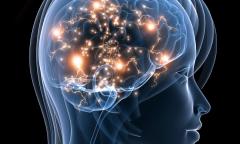New technique looks inside the brain to understand more about epilepsy
Dr Simona Balestrini, the Muir Maxwell Trust Research Fellow at Epilepsy Society and Honorary Clinical Associate Professor at UCL Queen Square Institute of Neurology, has embarked on a three year project using a pioneering technique to look at the activity of the brain in people with epilepsy. Here she explains what she hopes to achieve in her work with Transcranial Magnetic Stimulation (TMS) used in conjunction with electroencephalography (EEG).
We are at a very exciting time in our research into epilepsy. Genetic sequencing is beginning to generate large amounts of information with the potential to help us understand more about the causes of epilepsy and how we can best treat the condition.
When we sequence a person's DNA, we look at the three billion letters that are packaged within almost every cell of the body. This can help to clarify whether that person's epilepsy has a genetic contribution. But to make sense of that information, we also need to use other tools to interpret that information.
Genomics toolkit
TMS is a sophisticated tool that is part of our genomics toolkit. It is a means of looking inside a person's brain without using needles or electrodes and can be used to interpret information gained through genetic sequencing.
TMS uses a strong magnet, similar to the one used in the MRI scanner, to induce very brief electric currents in the brain. We can measure the response of cortical circuits in the brain to TMS and generate a direct profile of brain activity and function.
Put simply, TMS can establish a link between brain activity and different types of sensory, motor and cognitive functions. We can then establish whether a specific genetic change is impacting on the function of the brain.
How our muscles react
For some time we have been looking at the brain using TMS together with electromyography (EMG). This allows us to measure electrical activity of muscles and their reaction time. But this technique has only allowed us to look at the motor cortex in the brain.
Now with TMS-EEG (Transcranial Magnetic Stimulation used in conjunction with electroencephalography) we are able to look at brain activity across the whole of the cortical part of the brain. It can extend the area of the brain that is being investigated, guiding and monitoring potential treatment options.
By repeating the test over a period of time, TMS can be used to show the course of epilepsy in the brain and whether different medications lead to an improvement or a decline in the condition.
Individual drug response
We hope that in the future TMS will be used to help predict the way a person will respond to individual anti-epileptic medications. We also hope that it may help us to predict outcomes in epilepsy, including for example the risk of SUDEP (Sudden Unexpected Death in Epilepsy).
I am really excited about this project. I feel it will help us to gain a greater understanding of the causes of epilepsy and translate clinical research into clinical care. I really hope to make a difference to the lives of the people I see in clinic every day. If we can improve seizure control for people, we can improve their quality of life.
Epilepsy Society hosts amongst the best examples of transformational research being translated into care for people with epilepsy.
Find out more
TMS used to measure motor cortex excitability in alternating hemiplegia.
Genomics
Read how we are working to understand the genetic architecture of each individual person's epilepsy through our world leading genomics research programme.
Neuroimaging
Neuroimaging enables us to look deep inside the brain to learn more about the impact of seizures on its structure and function.
Neuropathology
The Epilepsy Society Brain and Tissue Bank is the first of its kind in the UK. It is dedicated to the study of epilepsy through brain and other tissue samples.



